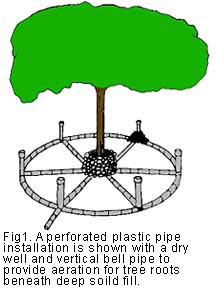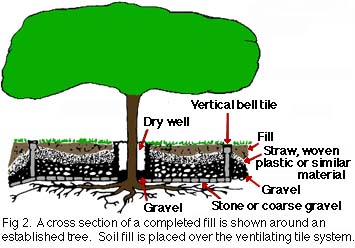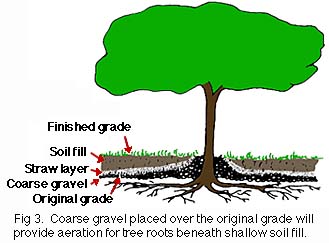Everett E. Janne, Extension Landscape Horticulturist (deceased)
Grade changes are frequently necessary while building sites are being prepared for construction. Often the building site has been chosen because of the presence of mature trees. However, any change in grade around existing trees can have a significant impact on their survival and future growth. Unless corrective steps are taken immediately, lowering the grade exposes the existing root system to the air and reduces the supply of nutrients and moisture available to the roots.
Raising the grade or soil level over existing roots can have an even greater effect on the future growth and survival of existing trees. When soil or any type of fill is placed over the existing root system, it causes a reduction in the oxygen supply to the tree roots and slows down the rate of gas exchange between the roots and the air in the soil pore space.
Both oxygen and water are essential to the growth, development and nutrient uptake by the roots. Many of the soil organisms also utilize the water and oxygen in their normal growth processes. Lack of oxygen in the soil may result in accumulation of noxious gases and chemicals detrimental to good growth. When this occurs, the feeder roots fail to develop, the root system and the above-ground portion of the tree begin to decline. Many factors (including tree species, depth and type of fill, drainage, soil structure below the fill and the general vigor of the existing tree) have a determining influence upon the time it takes for the above-ground symptoms to appear. Thus, it might take anywhere from several months to as much as 3 to 5 years before tree death would occur.
Determining Feasibility of Preventing Injury
When the grade around an established tree is being raised, careful consideration should be given to methods of preventing injury to the tree before the fill is made rather than attempting to take corrective measures after the damage has been done. While the initial cost may be high, preventing damage is always cheaper and more effective than attempting to correct the situation after the damage has been done.
Several important factors should be considered in attempting to determine whether the cost of saving the tree is worth the effort and expense of making the installations necessary to prevent or reduce extent of injury.
Density of Tree Population. Where trees are scarce, any attempt to save one or two sound trees is usually worthwhile. If there are numerous trees on the property, the property owner may not feel that the cost to save one or two in the immediate construction site is justified.
Species and Variety. Some of the fast-growing, short-lived trees may not be worth the cost of trying to save them. But a good healthy tree that is mature or adapted to the area, with a long life expectancy, is difficult to replace. For such trees, the expense of providing the necessary protection can frequently be justified.
Age and Vigor of Existing Trees. The condition of the tree is an important factor in determining its worth. If it has a large cavity, has been severely damaged by lightning or storm, or has lived out a normal life span, it is difficult to justify the expense and labor necessary to save the trees. This is especially true if there is danger of losing it to other causes. But a young, vigorous tree, if attractive and well placed, would be valuable enough to save.
Proper Installation of Deep Fill Around Existing Trees.
All vegetation should be removed, including sod and underbrush beneath the branch spread of the tree. Organic matter, as it decomposes beneath a soil fill, can create noxious gases detrimental to the tree roots.
The top 3 to 6 inches of the soil surface should be cultivated or broken up carefully so as to disturb the least possible amount of roots. This treatment allows better contact with the fill soil and prevents a sharp line of demarcation between the existing soil surface and the fill.
As a retainer around the trunk, an open-joint wall of shell, rock, masonry or brick in a circle around the tree trunk should be constructed with at least 1 to 2 feet between the trunk and the wall. The wall should be as high as the top of the new grade. The completed opening is commonly referred to as a tree well.
An aeration system can be constructed using 4-inch perforated plastic pipe arranged in 5 to 6 horizontal lines radiating from the tree well like spokes in a wheel to a point beyond the branch spread. The radial line should be installed so they slope from the tree trunk, thus allowing excess moisture to drain away. The outer ends of the radiating system should be connected with a circle of perforated plastic pipe as shown in Figure 1.

To provide vents, 4 or 6-inch plastic pipe or bell tile can be placed upright over the junction of the radial lines with the circle. These upright tiles should extend to the surface of the planned grade level and can be held in place with coarse gravel or stone. The low end of the aeration system should be extended to a curb, storm drain or sump to carry off excess moisture.
The exposed soil and the aeration system should be covered with rock or coarse gravel to a depth of 6 to 18 inches, depending on the amount of fill, followed by a covering layer of gravel. To prevent soil from filtering into the gravel and stone, a thin layer of straw, woven plastic or other porous material can be placed over the gravel and then filled in with good top soil to the desired or finished grade.
Placing sufficient coarse gravel in the tree well to cover the ends of the lines opening into the well will discourage rodents from eating the system. Coarse gravel can also be placed in the upright bell tile or plastic pipe and covered with a screen of grill to prevent rodents from making nests in the tile system. A vertical section of the completed fill can be seen in Figure 2.

A tree well can be left open. However, for safety purposes, it may be covered with a wooden deck or a metal grill. The well can also be filled with a mixture of coarse sand and charcoal (50% each, by volume) to within several inches of the top. This mixture can be covered with pea gravel, decorative bark or other attractive material to allow good air movement into the tile system.
An alternate method can be used where not over 24 inches of fill will be used, and where internal soil drainage is good. In this approach, no perforated pipe is used, only gravel. Again, all sod and underbrush must be removed, the soil surface broken up above the roots, and any needed fertilizer applied. Starting at the outer extremities of the branches, apply from 3 to 6 inches of coarse gravel or crushed stone. The depth towards the trunk of the tree should be increased gradually until it is 8 to 12 inches or deeper within 2 feet of the trunk. The gravel can reach the surface of the fill in the area extending 2 feet around the trunk of the tree (see Figure 3). The gravel can be covered with a thin layer of straw, woven plastic or other porous material to keep soil from filtering into the coarse gravel and sealing the air spaces. Some good top soil should be spread over the area to the desired depth (see Figure 3).

To Lower the Existing Grade
Less damage is likely to occur to a tree when the grade is lowered in the vicinity of the root zone unless great amounts of roots are exposed or removed. The removal of 1 to 2 inches of soil will not normally affect the growth of the tree, especially if steps are taken to prevent drought damage resulting from loss of roots. Terraces or retaining walls (see Figure 4) 
 can be used to avoid excessive soil loss in the area of greatest root growth. Corrective pruning of the top to compensate for the loss of roots will usually be necessary. Rather than being topped, much of the top growth should be thinned out by trimming out the lateral growth and cutting some of the main branches back to good side branches (see Figure 5). In this way, the normal shape of the tree is retained while the top growth can be reduced to a third or at least a half of its original size.
can be used to avoid excessive soil loss in the area of greatest root growth. Corrective pruning of the top to compensate for the loss of roots will usually be necessary. Rather than being topped, much of the top growth should be thinned out by trimming out the lateral growth and cutting some of the main branches back to good side branches (see Figure 5). In this way, the normal shape of the tree is retained while the top growth can be reduced to a third or at least a half of its original size.
If possible, a mulch of any type should be spread over the exposed area to help aid in preventing soil erosion, in cutting down on moisture loss, and in keeping soil temperatures more moderate. Provisions should also be made for adequate irrigation in the event of a prolonged drought.
Corrective Steps to Take After a Fill Was Made
If a fill has been in place long enough for visual symptoms of tree deterioration to occur, little can be done to save the tree. In cases where the fill has been made recently or where no serious damage has occurred, some corrective action can be taken.
If the increase is less than 12 inches, it is possible to remove soil around the tree trunk down to the original soil level for a radius of 2 feet beyond the trunk. A dry well should be installed around the trunk to hold the fill soil in place. Starting about two feet out from the dry well, holes should be drilled or dug every 2 feet beneath the branch spread. A 6-inch plastic pipe should be inserted and then filled with coarse gravel to allow free air and gas exchange in the root zone. This will usually suffice for a shallow fill.
Where deeper fills have been made, it will be necessary to install a pipe and gravel aeration system as described previously. The soil around the tree trunk should be excavated to the original grade with radial trenches extending to the outer limits of the branches. A well should be constructed around the trunk to keep back the soil. The radical trenches should be joined with a circular trench located at the dip line of the branches. The depth of the trenches should be dug to the original grade line and the system should slope sufficiently to provide good drainage away from the tree trunk. In order to carry off surplus moisture, it may be necessary to extend the radial line on the down hill side to a natural drain or into a sump or cistern. A 4-inch perforated plastic pipe aeration system should be installed and covered with gravel before replacing the soil back to the new grade line. The installation will be identical to that described previously, except the installation will have been made after the fill was installed.
Because there can be no assurance that a tree will recover from the damage already done, careful consideration must be given to the value of the tree in the landscape before expensive corrective measures are undertaken. The tree would have to be extremely attractive, valuable or have significant historical value to justify the expense of these corrective measures since success is not assured.
The preventive measures outlined in this publication will in most cases insure the continued life and usefulness of the tree (Figure 6). The decision the property owner must make after evaluating the aesthetic or landscape value of the tree and the cost of installation is whether the tree is worth the cost and effort involved.

The information given herein is for educational purposes only. Reference to commercial products or trade names is made with the understanding that no discrimination is intended and no endorsement by the Texas AgriLife Extension Service is implied.
Educational programs of the Texas AgriLife Extension Service are open to all people without regard to race, color, sex, disability, religion, age, or national origin.
Publication Revised November 2008

